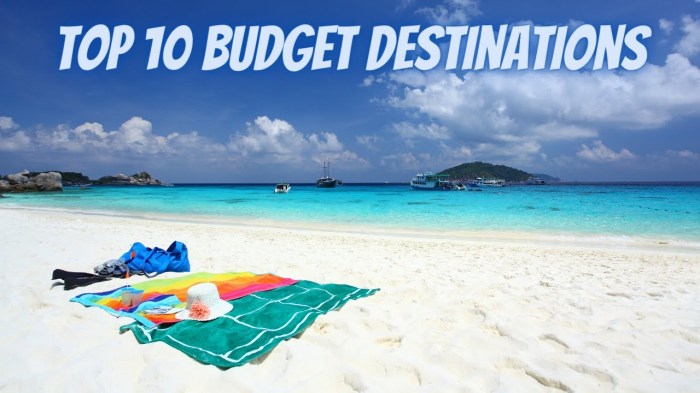Inexpensive Travel Destinations unlocks the secret to exploring the world without breaking the bank. This exploration delves into strategies for budget-conscious travelers, examining everything from choosing affordable destinations and leveraging cost-effective transportation to finding cheap accommodation and maximizing free or low-cost activities. We’ll analyze various budget levels, compare travel expenses across different regions, and offer practical tips and tricks for saving money without sacrificing the joy of discovery.
From backpacking through Southeast Asia to exploring budget-friendly European cities, we’ll uncover hidden gems and provide actionable advice to help you plan your next unforgettable, yet affordable, adventure. We’ll dissect the nuances of “inexpensive” travel, considering factors like travel style, duration, and personal preferences, ensuring our recommendations cater to a wide range of budgets and travel aspirations. The goal?
To show you that incredible travel experiences are within reach, regardless of your financial constraints.
Defining “Inexpensive”: Inexpensive Travel Destinations

The definition of inexpensive travel is highly subjective, varying significantly depending on individual circumstances and preferences. What constitutes a budget trip for one traveler might be considered extravagant for another. Factors such as travel style, trip duration, and the chosen destination all play a crucial role in shaping perceptions of affordability.The cost of travel is influenced by a complex interplay of factors.
Accommodation choices, from budget hostels to luxury resorts, dramatically impact overall expenditure. Similarly, transportation methods—budget airlines versus first-class flights, local buses versus private car rentals—represent significant cost variations. Food and beverage costs also vary widely, depending on whether travelers opt for street food, mid-range restaurants, or fine dining experiences. Finally, the cost of activities and attractions can range from free walking tours to expensive guided excursions.
Budget Levels and Destination Choices
Different budget levels naturally lead to different destination choices. A traveler with a daily budget of $50 might realistically only consider destinations with affordable accommodation and readily available inexpensive food options, potentially limiting their choices to Southeast Asia or parts of South America. In contrast, a traveler with a daily budget of $200 could consider a wider range of destinations, including parts of Europe or North America, potentially accessing more comfortable accommodations and a greater variety of activities.
Finally, a daily budget exceeding $500 opens doors to luxury destinations and high-end experiences worldwide. These budget variations fundamentally shape the type of travel experience and the destinations that become feasible.
Budget Travel Versus Luxury Travel: Key Cost Differentiators
The core difference between budget and luxury travel lies in the prioritization of cost versus comfort and convenience. Budget travel emphasizes maximizing experiences while minimizing expenses. This often involves choosing budget accommodations like hostels or guesthouses, utilizing public transportation, opting for affordable local food, and engaging in free or low-cost activities. Luxury travel, conversely, prioritizes comfort, convenience, and exclusivity.
This often involves staying in high-end hotels or resorts, using private transportation, indulging in fine dining, and participating in premium-priced activities and excursions. The cost differentiators are substantial, ranging from the type of accommodation and transportation to the quality and type of food consumed and the overall level of service received. For example, a budget traveler might opt for a shared hostel dorm room for $20 a night, while a luxury traveler might book a private suite in a five-star hotel for $500 or more.
Similarly, budget travelers might rely on local buses, while luxury travelers might hire private drivers or utilize first-class air travel.
Geographic Regions
Southeast Asia, South America, and Eastern Europe represent compelling options for budget-conscious travelers, each offering a unique blend of cultural immersion, natural beauty, and affordable experiences. These regions consistently rank highly in affordability indices, providing a significant return on investment for travelers seeking value. Their diverse landscapes and rich histories cater to a wide range of interests, ensuring a fulfilling and cost-effective journey.
Southeast Asia’s Diverse Offerings
Southeast Asia boasts a captivating tapestry of vibrant cultures, stunning landscapes, and delicious cuisine, all at remarkably affordable prices. From the bustling street markets of Bangkok to the serene rice paddies of Bali, the region offers a diverse range of experiences. The cost of living, particularly in accommodation and food, is significantly lower than in many Western countries.
Transportation options, such as local buses and trains, are readily available and inexpensive. The region’s warm climate also reduces the need for extensive clothing purchases, further contributing to its affordability.
South America’s Untapped Potential
South America presents a compelling alternative for budget travelers seeking authentic experiences and breathtaking scenery. While some areas are developing rapidly, many regions retain a charm and affordability that’s hard to match elsewhere. The cost of living, especially in smaller towns and cities, is remarkably low, allowing for extended stays on a modest budget. Local transportation, while sometimes less efficient than in developed nations, remains relatively inexpensive.
The continent’s stunning natural wonders, from the Amazon rainforest to the Andes Mountains, offer incredible opportunities for adventure without the hefty price tags found in similar destinations elsewhere.
Eastern Europe’s Historical Charm
Eastern Europe offers a fascinating blend of history, culture, and natural beauty at significantly lower prices than many Western European destinations. The region’s rich history is reflected in its well-preserved architecture, charming towns, and fascinating museums. The cost of accommodation, food, and transportation remains relatively low, particularly when compared to Western counterparts. The region also benefits from a strong network of budget airlines, making it easier and more affordable to explore multiple countries within a short timeframe.
Accommodation Options for Budget Travelers, Inexpensive Travel Destinations
The following table highlights affordable accommodation options available in each region:
| Destination | Accommodation Type | Average Price (USD/night) | Key Features |
|---|---|---|---|
| Bangkok, Thailand (Southeast Asia) | Hostel Dorm Bed | 10-20 | Social atmosphere, central location, shared facilities |
| Medellin, Colombia (South America) | Airbnb Private Room | 25-40 | Local experience, kitchen access, more privacy |
| Budapest, Hungary (Eastern Europe) | Budget Hotel | 30-50 | Cleanliness, basic amenities, central location |
| Hoi An, Vietnam (Southeast Asia) | Homestay | 15-30 | Cultural immersion, home-cooked meals, local insights |
| Cusco, Peru (South America) | Basic Guesthouse | 20-35 | Simple accommodation, close to attractions |
| Krakow, Poland (Eastern Europe) | Hostel Private Room | 20-35 | More privacy than dorm, shared facilities |
Activities and Experiences

Budget travel doesn’t mean sacrificing enriching experiences. Many inexpensive destinations offer a wealth of free or low-cost activities that can be just as memorable, if not more so, than pricey tourist traps. The key lies in thoughtful planning and a willingness to embrace local culture and simpler pleasures. By focusing on authentic experiences and avoiding unnecessary expenses, travelers can maximize their enjoyment and minimize their spending.Exploring inexpensive travel destinations provides opportunities to engage in activities that are both budget-friendly and culturally immersive.
Savvy travelers can leverage free resources and prioritize experiences over material purchases, thereby creating lasting memories without breaking the bank. This approach allows for a deeper connection with the destination and its people, often leading to more rewarding travel experiences than those focused solely on luxury amenities.
Free and Low-Cost Activities
Numerous options exist for experiencing a destination without significant financial outlay. Many cities offer free walking tours, providing historical context and insider tips. Local markets present a vibrant cultural immersion, offering a glimpse into daily life and the opportunity to sample regional delicacies at affordable prices. Similarly, parks and nature reserves often provide scenic hiking trails and opportunities for birdwatching or simply enjoying the tranquility of nature.
Free museums or those with reduced admission days are also common, allowing access to art, history, and cultural heritage without hefty fees.
Maximizing Enjoyment While Minimizing Expenses
Strategic planning is crucial for maximizing the value of a budget trip. This involves researching free activities beforehand, utilizing public transportation instead of taxis or ride-sharing services, and seeking out local eateries rather than tourist-oriented restaurants. Packing light minimizes baggage fees, and preparing some meals independently can significantly reduce food costs. Taking advantage of free Wi-Fi eliminates roaming charges, and learning basic phrases in the local language can enhance interactions and open up opportunities for authentic experiences.
For instance, a traveler in Southeast Asia might choose to take a local bus instead of a private car, saving significant money while immersing themselves in daily life. Similarly, preparing simple meals using ingredients from local markets can provide delicious and affordable alternatives to restaurant dining.
Budget-Friendly Activities by Category
Prioritizing specific types of activities can further enhance the budget travel experience.
- Cultural Activities: Visiting free museums on designated days, attending free concerts or performances in parks, exploring local markets and interacting with vendors, participating in free walking tours.
- Outdoor Activities: Hiking or biking on scenic trails, picnicking in parks or by the beach, exploring beaches and coastlines, stargazing in areas with minimal light pollution.
- Historical Activities: Visiting historical sites with free or discounted admission, exploring historical neighborhoods on foot, attending free lectures or talks related to local history.
Food and Drink
Savvy travelers understand that food and drink costs can significantly impact a trip’s overall expense. Budgeting effectively in this area is crucial for maintaining affordability, particularly when exploring inexpensive destinations. This section Artikels the typical costs associated with food and drink in various budget-friendly locations and provides practical strategies for minimizing expenses while still enjoying authentic culinary experiences.Eating affordably doesn’t necessitate sacrificing quality or cultural immersion.
In fact, embracing local eating habits often leads to the most authentic and budget-friendly meals.
Food and Drink Costs in Inexpensive Destinations
Southeast Asia (countries like Vietnam, Thailand, Laos) consistently ranks among the cheapest regions for food. A simple street food meal, such as a bowl of pho in Vietnam or pad thai in Thailand, can cost as little as $1-$3. Local markets offer incredibly affordable produce, meats, and seafood, allowing for self-catering options. In contrast, while still relatively inexpensive, South America (e.g., parts of Colombia, Ecuador) might see street food prices ranging from $2-$5, with market costs varying depending on location and seasonality.
Eastern Europe (e.g., Bulgaria, Romania) presents another attractive option, where a hearty meal at a local restaurant could range from $5-$10. These price points represent averages and can fluctuate based on location, season, and restaurant type. A high-end restaurant experience will naturally command a higher price in all locations.
Strategies for Affordable Eating
Prioritizing street food and local markets is a cornerstone of affordable eating. Street food often represents the most authentic culinary experiences, reflecting local tastes and traditions at incredibly low prices. Local markets offer a chance to buy fresh ingredients and prepare meals independently, further reducing costs. Avoiding tourist traps and opting for smaller, family-run establishments typically results in lower prices.
Lunch menus (“menu del dia”) are common in many parts of Latin America and Europe, offering substantial meals at discounted prices. Finally, taking advantage of free breakfast options provided by some hostels or guesthouses can further stretch the food budget.
Sample Food and Drink Budget: One Week in Southeast Asia
Let’s consider a hypothetical week-long trip to Southeast Asia, specifically focusing on Vietnam.
| Category | Daily Cost (USD) | Weekly Cost (USD) |
|---|---|---|
| Street Food (Breakfast & Lunch) | $5 | $35 |
| Local Market Dinner (Cooking Some Meals) | $3 | $21 |
| Snacks & Drinks | $2 | $14 |
| Occasional Restaurant Meal | $10 | $10 |
| Total Weekly Food & Drink Budget | $80 |
This budget allows for a diverse culinary experience, incorporating both street food and self-catering, while still leaving room for the occasional restaurant meal. Adjustments should be made based on personal preferences and the specific destination. This is a conservative estimate; many travelers spend significantly less.
Ultimately, inexpensive travel is less about deprivation and more about smart planning and resourcefulness. By carefully considering your travel style, destination choices, and spending habits, you can unlock a world of affordable adventures. This guide serves as a roadmap, equipping you with the knowledge and tools to navigate the complexities of budget travel and create lasting memories without emptying your wallet.
Remember, the most enriching experiences often lie beyond the well-trodden tourist paths – and often come at a fraction of the cost.

